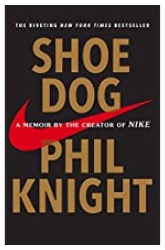I just finished reading Shoe Dog for the second time. It was a great book. I liked the book so much, I considered requiring it in class.
To create and run a successful organization like Nike, you would think that Phil Knight must have been a great, charismatic leader, but Knight’s own memoir paints a different picture.
He was not a leader in a classical sense. He was a failed encyclopedia salesman. He was shy. As a manager, he was hands-off to a fault. While he was successful, he might receive low marks for many classical leadership traits. Nevertheless he did three important things extraordinarily well:
- He was passionate about shoes
- He was persistent in the face of obstacles
- He assembled a great team.
The first (passion) led to the second (persistence) as it usually does, but he would never have scaled without a team. Without a team, he would still be selling shoes out of the trunk of his car.
The Team
Much of the team at Blue Ribbon (Later Nike) unsurprisingly was comprised of athletes—mostly runners. They included:
- Phil Knight: The founder of Blue Ribbon. He began by importing Tiger running shoes from Japan. That was his business until circumstances forced him to manufactures his own shoes.
- Bill Bowerman: Phil’s Track coach at the University of Oregon. He was also the US Olympic track coach. He became Knight’s partner. He was the driving force behind several technological innovations we commonly attribute to Nike.
- Jeff Johnson: A former runner. He became Blue Ribbon’s first full-time employee in 1965. Sales doubled each year largely due to Johnson’s obsessiveness.
- Bob Woodell: Another former runner who was crippled in an accident. He was thrilled to still work in a sporting goods company. He improved everything he touched.
- Delbert Hayes: A brilliant accountant who was inspired by numbers.
- Cousin Doug Houser: Phil’s cousin. He was a trusted advisor who defended Blue Ribbon in their first lawsuit.
- Rob Strauser: Blue Ribbon’s first in-house lawyer who became their chief negotiator.
- Steve Prefontaine (AKA Pre): Perhaps the most well-known runner in Oregon. He was an Olympian who held several American records in running. He was the archetypical athlete who embodied the brand. Eventually, the team of endorsers expanded to include endorsers from Michael Jordan to Kobe to Tiger.
Here is the interesting part. Phil didn’t:
- Design new innovative shoes (that was Bowerman)
- Manufacture the shoes himself (they were sourced to factories in Japan, Mexico, China, etc.). At first, he was just an importer of an existing brand.
- Market the shoes (this was Johnson’s idea)
- He was not a super-star endorser (Pre was the ideal athlete; Phil was just a pretty-good runner)
- He didn’t even create the Swoosh Logo (that was designed by a college kid)
- He didn’t start out with a strategic plan to create Nike (creating Nike was more of an accident, born from the circumstances). [i]
Yet, Phil did one thing well. Yet he brought them all together and orchestrated the plan. Plan is really too strong a word. He provided direction and his team did the rest. And this is the point.
Small business people are used to being chief, cook, and bottle washer, but there is only so much time in the day. To expand and grow, at some stage you have to reach beyond yourself and create impact through others.
If you don’t have a team, a network is a loose team. Look around. The people to your left and your right have abilities that you do not possess. They can make things happen quickly.
For example, at my last Great Business Networking (GBN) meeting, one member asked a number of technical questions about buying a house. A realtor, mortgage broker, insurance salesperson, and real estate photographer answered all of her questions easily and efficiently. As I listened to this discussion, I wondered how many weeks or months it would have taken her to answer those technical questions on her own—questions that just rolled off the tongues for this ad-hoc team of professionals.
What About You?
Who is on your team? If you don’t have one, how can you assemble a networked team?
References
[i] Knight, P. (2016). Shoe Dog: A memoir from the creator of Nike.
___________

Dr. Darin Gerdes is a tenured Professor of Management in the College of Business at Charleston Southern University.
All ideas expressed on www.daringerdes.com are his own.
This post was originally created for Great Business Networking (GBN), a networking organization for business professionals where Dr. Gerdes is the Director of Education.
___________

